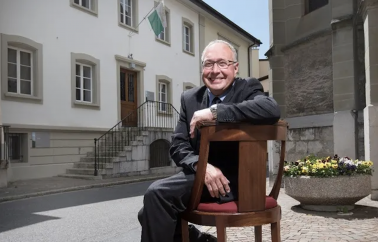
The role of the STRs in the implementation by municipalities of emergency meeting points in connection with the supply of energy resources and also the internal social climate - by Daniel Flotron, Prefect of the district of Lavaux, Switzerland
The consequences of the war in Ukraine - how does it affect our countries?
working group C
Impact on economic and social policies (supply of energy resources and agricultural products, tourism policy and freedom of international movement, internal social climate)
The role of the STRs in the implementation by communes of emergency meeting points in connection with the supply of energy resources and also the internal social climate (reassure the population).
By Mr. Daniel Flotron
Prefect of the district of Lavaux-Oron
Canton of Vaud - Switzerland
Communes are essential partners in the event of a crisis. They know perfectly their population and the infrastructures located on their territory.
What are the legal bases determining the responsibilities of communes with regard to emergency meeting points?
Articles 2, paragraph 2 and 43, paragraph 1 of the law of February 28, 1956 on communes (Vaudois legal basis N°175.11) attribute to communes - and to municipalities more particularly - the power to take the necessary measures to maintain public order, by which is meant in particular the protection of persons. The establishment of meeting points is one such measure, as it ensures that in the event of a crisis, people who need help can find it and contact the emergency services.
What is the purpose of emergency meeting points?
Emergency meeting points make it possible to guarantee the population the following minimum services during an event that is out of the ordinary, such as a breakdown in the distribution of electricity, namely:
• Guarantee a channel of communication with the authorities;
• Temporarily take care of the vulnerable resident population and direct them to adequate accommodation;
• Take charge of requests relating to distress and emergency situations in order to route them to the emergency centers (112-117-118-144).
This last point is particularly sensitive, because of the probable difficulty of access to the mobile network, the Internet and telephony in the event of power cuts of the electricity network or heavy limitations. In this case, the only means of communication available to reach the emergency centers will be the POLYCOM radio network, and - to a lesser extent - the VHF network of the fire and rescue services. The decentralization of radio stations in the meeting points will thus allow people in need to report their situation, then to the emergency centers to commit the appropriate means.
On the other hand, it is not topical to deliver medical services there or to assume responsibility for taking charge of the emergency situations mentioned above.
National concept
In this regard, it should be noted that this concept was developed by the Federal Office for Civil Protection and is already in force in several cantons, in particular Bern, Zurich, Aargau, Lucerne and even Solothurn and will be deployed in all the French-speaking cantons (www.pointrencontreurgence.ch).
Where should the emergency meeting point be located?
The place chosen for a meeting point must meet the criteria set out in the checklist established by the State.
Ideally, in public buildings such as premises of the municipal administration, municipal halls, schools or possibly buildings known to the population (restaurant, sports complex, etc.). The places must be visible and accessible. The “energy backup” aspect guaranteeing autonomy in the event of a power failure is decisive.
What is the role of communal staff in the context of emergency meeting points?
Communes are responsible for planning the deployment of the meeting points. About 1 per 5,000 inhabitants.
The communal staff is very involved: it is they who will be called upon to operate the meeting point, potentially with the support of volunteers and/or external companies on behalf of the communal authorities.
What is the investment required for the communes?
Emergency meeting points do not require too much investment from communes, subject to the electricity supply. As a rule, the planned structure is already used by the communes for other activities. Part of the equipment is made available by the canton such as radios, banners, general signage. It is also important to specify that the Regional Civil Protection Organisations, full partners in the protection of the population, provide support in organizing the implementation of these meeting points and ensuring the staff training.
Under what circumstances would emergency meeting points be used?
The meeting points will be activated by decision of the Council of State or the cantonal crisis management staff in the event of a disaster or an emergency situation, so that the population of a threatened or disaster-stricken area can go to an emergency meeting point, a pre-determined place close to her, to find the information and help it needs.
This could be the case in the context of an energy crisis but also for any other major event endangering the population.
Daniel Flotron
Prefect of the district of Lavaux-Oron
Canton of Vaud - Switzerland



